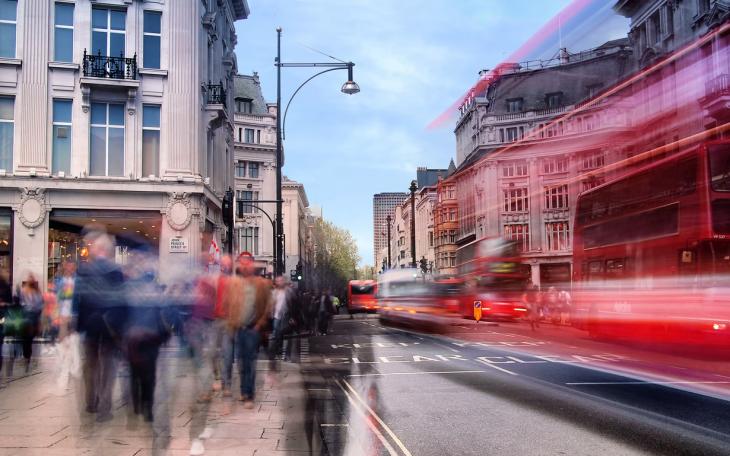The nation’s favourite high street can’t catch a break

By Ben Monteith
For a street so stubbornly straight, Oxford Street’s modern history is about as full of twists and turns as it could possibly be.
Over the past two decades, there have been numerous attempts to modernise what its local authority Westminster City Council (WCC) calls, ‘the nation’s favourite high street’. Attempts which seem, at least if you’re following it from afar, to have failed miserably.
Yet there have been successes. The Crown Estate’s work to improve Regent Street, supported by WCC, is a case in point. Regent Street has become a far more pleasant ‘pedestrian and dwell’ environment, with wider pavements, greenery and seating areas, whilst retaining an incontrovertible retail draw, with the likes of Gymshark opening its flagship (and only physical space in the world) there.
Meanwhile, as part of the WCC-led Oxford Street District regeneration, the creation of a ‘photography quarter’ in an alcove nestled between the M&S towards the east of Oxford Street and the Palladium theatre on Great Marlborough Street, is a victory for cultural placemaking.
And yet… there are few things that both the British media and the public love more than to go off on one over the nation’s favourite high street. The M&S on the western part of Oxford Street, at Marble Arch, is in the news as the pinnacle in a national conversation about retrofit vs. rebuild. The ‘American candy stores’ that proliferate Oxford Street are used on one hand (including by your author) to generate likes for social media and on the other, to bash Oxford Street.
Meanwhile, WCC has announced relatively quietly that it has shelved part of its plans improve Oxford Street, including the part-pedestrianisation of Oxford Circus.
Which raises the question: why is Oxford Street such a circus? When everyone (seemingly) agrees that something needs to happen, why doesn’t it? And what might come next?
Real estate challenges
Retail property on Oxford Street ranks as some of the most expensive in the UK, if not the world. While that means rents can be high, a big concern for retailers in the area is business rates.
Business rates, calculated based on the value of the property (which haven’t been revalued for years and are therefore based on pre-pandemic and largely pre-online shopping boom values), are an almost entirely insurmountable challenge for Oxford Street right now. Westminster as a borough is the largest collector of business rates in the UK, with business rates a significant source of income for HM Treasury, making the case for reform (among the government, at least) frustratingly slow. Meanwhile, while retail values would be expected to decline after the 2023 revaluation, here comes inflation to take any of the benefit out of the process.
Amid challenges to retail in general, landlords try to minimise the damage to their own incomes and portfolios. That’s in part why you see the subleases that lead to American candy stores.
That cacophony of landlords looking to protect their investments is also representative of the fragmented property ownership of Oxford Street.
Not only is it fragmented, it’s seriously fragmented among a range of big beasts. You have the likes of The Crown Estate, Grosvenor and The Portman Estate on one hand, and then less traditional players such as Lazari, Pontegadea (retailer Zara’s real estate sister company) and overseas investors from across the world, of varying degrees of exposure.
Each has different visions for their property and different levels of willingness to contribute to regeneration efforts. While the likes of Grosvenor are focused on improving the streets and public spaces (Grosvenor Square being a notable example of a large regeneration), and seem more than willing to work with partners on common objectives, managing each party on such an iconic stretch of land is not a small time commitment.
Stakeholder engagement is a quagmire
In part because of the fragmented land ownership, the New West End Company – the area’s business improvement district – wields immense influence. Best known, perhaps, for coordinating Oxford Street’s Christmas lights displays, NWEC is an outspoken lobbyist for the area, frequently sharing its views in trade and consumer media.
While NWEC, on behalf of many of the area’s businesses, has broadly been in favour of pedestrianisation (at least on parts of the streets), it goes against another vocal lobby: the residents’ groups. Many of those who live in central London, understandably, want to minimise traffic and other disruption from outside their homes. It’s why WCC ran into so much difficulty during the pandemic with its al fresco dining policies, with Soho residents unhappy with the noise.
Amid stakeholders with so many conflicting demands – and we’re not even looking at the tourists here, who probably quite like the focus on retail in the area – any movement is rife with difficulty.
So… what happens next?
Those are just a few of the surface issues. Taxi and bus routes, cycling and active travel campaigns, political footballing and many more can all be make-or-break for reform.
They’re challenges that the still relatively newly Labour-run Westminster City Council is wrapping its head around. With the Mayor of London likely to remain Labour as well, perhaps the enmity between the capital’s most influential borough and City Hall can be resolved yet.
With WCC having already suggested bold action, such as an increase in compulsory purchase orders to force property owners to play ball, and already carried out other bold moves such as raids on allegedly tax-evading properties, perhaps the logjam will end.
Or perhaps it won’t. But those of us who have a soft spot for Oxford Street –if you search ‘Oxford Street’ on Twitter you’ll see a stream of nostalgic posts about people’s first jobs or their visits to London as children – will keep on hoping for a real reimagination of the nation’s favourite high street.









